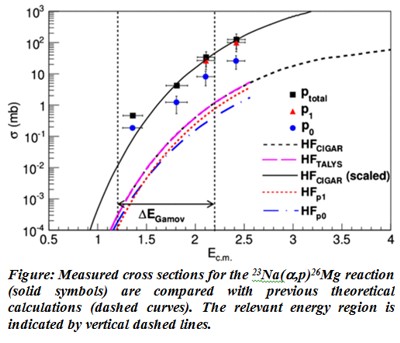Measurement of the 23Na(α,p)26Mg reaction at energies relevant for the production of Galactic 26Al
Gamma-ray astronomy has proven to be a powerful tool for understanding explosive nucleosynthesis in supernovae and novae. In particular, the observation by earth-orbiting satellites of 26Al in the galactic interstellar medium via its 1809-keV gamma ray confirmed that active nucleosynthesis takes place in our Galaxy. This observation also provides strong constraints for stellar and supernova nucleosynthesis models. The exact origin of 26Al remains controversial, although the irregular distribution of 26Al emission along the plane of our Galaxy provides the main argument for the hypothesis that production of this radioactive isotope occurs mainly in massive stars. The observation of this emission is possible because the decay half-life of 26Al (7.2 x 105 years) is much longer than the mean time between galactic supernovae and novae explosions.
 In order to correctly interpret these observations, all mechanisms that synthesize or destroy 26Al in astrophysical environments must be understood and quantified. In the C/Ne convective shell of a pre-supernova star, at temperatures of the order of 1.25 Giga Kelvin (GK), the production of 26Al is dominated by the 25Mg(p,γ)26Al reaction, where the main source of protons for this mechanism was thought to come primarily from carbon burning reactions.
In order to correctly interpret these observations, all mechanisms that synthesize or destroy 26Al in astrophysical environments must be understood and quantified. In the C/Ne convective shell of a pre-supernova star, at temperatures of the order of 1.25 Giga Kelvin (GK), the production of 26Al is dominated by the 25Mg(p,γ)26Al reaction, where the main source of protons for this mechanism was thought to come primarily from carbon burning reactions.
Work at Argonne has, however, shown that the 23Na(α,p)26Mg reaction is another important source of protons that can affect the production of 26Al in these scenarios. The cross section for 23Na(α,p)26Mg was previously based on theoretical models since there was no reliable experimental information. At Argonne, the cross section for the 23Na(α,p)26Mg reaction has recently been measured at energies relevant for the production of 26Al in massive stars using a helium gas target and a 23Na beam from the ATLAS facility. It was found that the cross sections exceed the theoretical predictions by nearly a factor of 40. Thus, the rate of proton production via this mechanism is much higher than previously thought, see figure. This change in the cross section will strongly affect the production of 26Al in massive stars and the contribution to proton production from the 23Na(α,p)26Mg reaction should now be correctly incorporated into the astrophysical models.
Reference
- S. Almaraz-Calderon et al., Phys. Rev. Lett. 112, 152701 (2014).
![[Argonne Logo]](/images/argonne_header_logo.jpg)
![[DOE Logo]](/images/header_doe.gif)